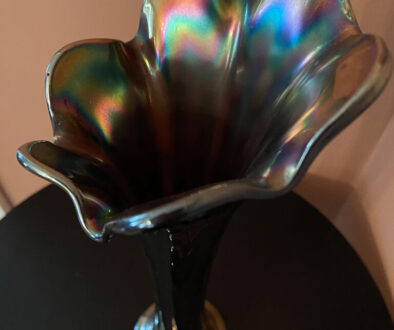Hosta la Vista

When we think of perennials, we most often picture lovely flowers, even though they may only bloom for a few weeks each year. Rarely are they grown primarily for their foliage—except for hostas. Loved by many, they are consistently voted a gardener’s favorite perennial.
Hostas have come a long way since the first shipment arrived from Japan in 1862. Today there are over 4,000 cultivars from which to choose and they are the most widely grown ornamental perennial in the U.S. They vary in size from a mere four inches wide to over six feet and are one of the easiest, most forgiving plants to grow. Make sure you pay attention to their mature size when you plant them.
Lovely Blossoms?
Although their foliage is the main attraction, hostas bloom just like other herbaceous perennials. Their funnel-shaped flowers appear atop long stalks called scapes and like lilies, each flower only blooms for one day. However, each scape can produce up to fifty flowers that open sequentially, so the plant actually blooms for about three weeks. The blossoms can be lavender, light blue, pink, or white, and some are even fragrant. Depending on the cultivar, they bloom anywhere from early summer to early fall.
Some people dislike the flowers and cut them off as soon as the scapes appear. This practice is perfectly fine and will not harm the plant. But, if you allow them to bloom, bees, butterflies, and hummingbirds love them. Cut off the scapes when about three-quarters of the buds have opened. This keeps the plant from using energy to set seeds instead of growing more leaves and roots.


Hostas are shade lovers although some can tolerate more sun than others. Try to avoid planting them under trees that have aggressive surface roots (like beech, birch, cherry, maples, and willows) as their roots will compete with your hostas for water and other nutrients. They like well drained soils and are heat and somewhat drought tolerant. I used to say, “You can’t kill them.” However, one year my irrigation system failed during a lengthy drought, and I lost a number of my most precious varieties. Please note: Unlike all the other colors, white hostas are somewhat delicate and cannot tolerate too much sun. Plant them where they will get morning sun or in dappled shade and make sure they get enough water, but not too much.
Hostas are long-lived plants. So much so, that many may outlive the gardener, and they don’t need much fertilizer, if any. If you use one, don’t apply it after July because it will interfere with the plant’s process of getting ready for winter.
Chameleons
Many hostas change color as the season progresses, as they are affected by heat and sunlight. Some get darker, some get lighter, some of the creamy white colors change to pure white. Some of the blue ones will turn green. This happens because the blue ones are not actually blue. They appear that way because of the way light reflects off the waxy coating on their leaves. That coating seems to almost melt off due to heat, harsh watering, or some pesticides. Once that coating is gone, it will not come back that year. But don’t fret. The plant will be fine, and the blue color will be back again next year. Plant your blue varieties where they will be protected from hot afternoon sun and be sure to water them at their base.
The other unwanted effect that too much sun can have is the reversion of some variegated varieties back to a solid color, most likely the hue of one of its parents.


Easy Breezy
Hostas require almost no maintenance. Cut off the flower stalks after they bloom and clean up the leaves after they die back in the fall—that’s it. Unlike irises, they do not need to be divided regularly. If they get crowded, they simply slow their growth. If you choose to divide them, do so in early spring, right after the “eyes” (growing tips) emerge from the ground. This is also the best time to transplant them. Although I have successfully divided them in the heat of the summer, it is so much easier to do so before the leaves mature—especially when transplanting large varieties.
Hostas have very few enemies except deer. Here in Cape May we don’t have any (on the island at least). But if you do, plant them behind a tall impenetrable fence! In deer country they are referred to as deer lettuce—one of their favorite foods. Rabbits also are reported to like them. So far, they have left mine alone, preferring to nibble on my ferns. You should also watch for slugs and snails.
Design
Hostas are at home in any setting, from cottage gardens to contemporary landscapes. Here are a few ideas to get you started:
1. Use larger varieties in a row as a backdrop for other plants or use one as a focal point in your landscape.
2. Smaller specimens can be used to line the front of a garden bed or walkway.
3. Create a hosta garden using a few different varieties. Try to vary the size of the leaves and the plants themselves. I like to use a mirror image concept. In other words, if you have chosen a cultivar that is yellow with a green margin, choose another that is the reverse—green with a yellow margin. Tuck in a few miniature solid yellow ones, too.
4. Combine them with other shade loving perennials like ferns, astilbe, coral bells, bleeding heart, lamium, and hakonechloa, or annuals like purple torenia and yellow tuberous begonias.
5. Use medium-sized varieties in a container as a specimen plant or combine smaller ones with other perennials and annuals.
6. Brighten a shady spot with some yellow or white variegated varieties or chartreuse cultivars.
It’s no wonder people love hostas so much. I know of no other plant with such a wide variety of colors, sizes, and interesting features. The leaves can be smooth or deeply veined, striped or curly, solid or variegated. Recently, breeders have even introduced hostas with red stems!



